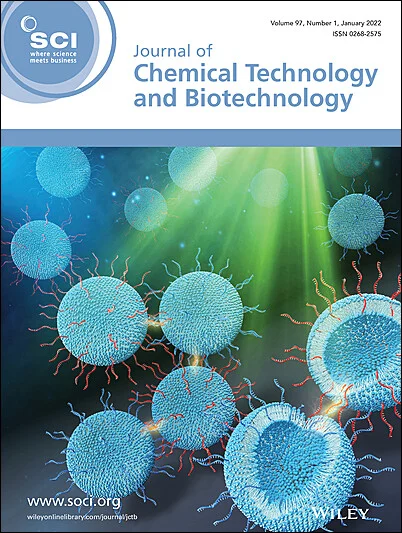Darya A Konovalova, Anton P Koskin, Sergey A Stepanenko, Roman G Kukushkin, Daniil I Lashchenko, Petr M Yeletsky, Vadim A Yakovlev
求助PDF
{"title":"使用多相催化剂的木质纤维素生物质转化为乙二醇:一个小型综述","authors":"Darya A Konovalova, Anton P Koskin, Sergey A Stepanenko, Roman G Kukushkin, Daniil I Lashchenko, Petr M Yeletsky, Vadim A Yakovlev","doi":"10.1002/jctb.70052","DOIUrl":null,"url":null,"abstract":"<p>Ethylene glycol (EG) is known to be a large-tonnage industrial chemical produced mainly <i>via</i> energy-intensive processes from ethylene oxide generally obtained from petroleum feedstock. At the same time, lignocellulosic biomass represents a green and sustainable alternative to the fossil feedstocks for EG production. Beside the properly selected reaction conditions, the key point of success for this complex process is in the development of a suitable multifunctional catalyst ensuring necessary rates of the reactions. This mini-review article surveys recent achievements in the development of heterogeneous catalysts for the conversion of cellulose into green ethylene glycol – both extracted and in the composition of lignocellulose biomass. The literature review showed that utilization of W-based and Ni or Ru-based catalysts allows for achievement of promising ethylene glycol yields from lignocellulose biomass (~ 40–60 wt. %). However, using real biomass feedstocks remains quite challenging and requires additional research as now only more than dozen reports present in the literature. In addition to summarizing current progress, this article outlines future research directions aimed at developing robust, low-cost, and scalable catalytic systems suitable for practical application. By promoting biomass-derived EG production, this work contributes to the advancement of sustainable chemical manufacturing, energy security, and rural biomass valorization – offering potential socioeconomic benefits through reduced dependence on fossil resources, lowered carbon footprint, and enhanced regional circular bioeconomies. © 2025 Society of Chemical Industry (SCI).</p>","PeriodicalId":15335,"journal":{"name":"Journal of chemical technology and biotechnology","volume":"100 11","pages":"2251-2258"},"PeriodicalIF":2.4000,"publicationDate":"2025-08-26","publicationTypes":"Journal Article","fieldsOfStudy":null,"isOpenAccess":false,"openAccessPdf":"","citationCount":"0","resultStr":"{\"title\":\"Lignocellulosic biomass conversion into ethylene glycol using heterogeneous catalysts: a mini-review\",\"authors\":\"Darya A Konovalova, Anton P Koskin, Sergey A Stepanenko, Roman G Kukushkin, Daniil I Lashchenko, Petr M Yeletsky, Vadim A Yakovlev\",\"doi\":\"10.1002/jctb.70052\",\"DOIUrl\":null,\"url\":null,\"abstract\":\"<p>Ethylene glycol (EG) is known to be a large-tonnage industrial chemical produced mainly <i>via</i> energy-intensive processes from ethylene oxide generally obtained from petroleum feedstock. At the same time, lignocellulosic biomass represents a green and sustainable alternative to the fossil feedstocks for EG production. Beside the properly selected reaction conditions, the key point of success for this complex process is in the development of a suitable multifunctional catalyst ensuring necessary rates of the reactions. This mini-review article surveys recent achievements in the development of heterogeneous catalysts for the conversion of cellulose into green ethylene glycol – both extracted and in the composition of lignocellulose biomass. The literature review showed that utilization of W-based and Ni or Ru-based catalysts allows for achievement of promising ethylene glycol yields from lignocellulose biomass (~ 40–60 wt. %). However, using real biomass feedstocks remains quite challenging and requires additional research as now only more than dozen reports present in the literature. In addition to summarizing current progress, this article outlines future research directions aimed at developing robust, low-cost, and scalable catalytic systems suitable for practical application. By promoting biomass-derived EG production, this work contributes to the advancement of sustainable chemical manufacturing, energy security, and rural biomass valorization – offering potential socioeconomic benefits through reduced dependence on fossil resources, lowered carbon footprint, and enhanced regional circular bioeconomies. © 2025 Society of Chemical Industry (SCI).</p>\",\"PeriodicalId\":15335,\"journal\":{\"name\":\"Journal of chemical technology and biotechnology\",\"volume\":\"100 11\",\"pages\":\"2251-2258\"},\"PeriodicalIF\":2.4000,\"publicationDate\":\"2025-08-26\",\"publicationTypes\":\"Journal Article\",\"fieldsOfStudy\":null,\"isOpenAccess\":false,\"openAccessPdf\":\"\",\"citationCount\":\"0\",\"resultStr\":null,\"platform\":\"Semanticscholar\",\"paperid\":null,\"PeriodicalName\":\"Journal of chemical technology and biotechnology\",\"FirstCategoryId\":\"5\",\"ListUrlMain\":\"https://scijournals.onlinelibrary.wiley.com/doi/10.1002/jctb.70052\",\"RegionNum\":4,\"RegionCategory\":\"生物学\",\"ArticlePicture\":[],\"TitleCN\":null,\"AbstractTextCN\":null,\"PMCID\":null,\"EPubDate\":\"\",\"PubModel\":\"\",\"JCR\":\"Q3\",\"JCRName\":\"BIOTECHNOLOGY & APPLIED MICROBIOLOGY\",\"Score\":null,\"Total\":0}","platform":"Semanticscholar","paperid":null,"PeriodicalName":"Journal of chemical technology and biotechnology","FirstCategoryId":"5","ListUrlMain":"https://scijournals.onlinelibrary.wiley.com/doi/10.1002/jctb.70052","RegionNum":4,"RegionCategory":"生物学","ArticlePicture":[],"TitleCN":null,"AbstractTextCN":null,"PMCID":null,"EPubDate":"","PubModel":"","JCR":"Q3","JCRName":"BIOTECHNOLOGY & APPLIED MICROBIOLOGY","Score":null,"Total":0}
引用次数: 0
引用
批量引用


 求助内容:
求助内容: 应助结果提醒方式:
应助结果提醒方式:


